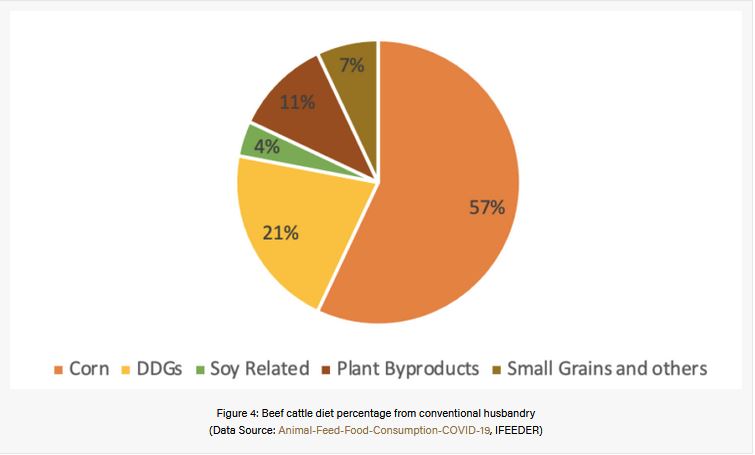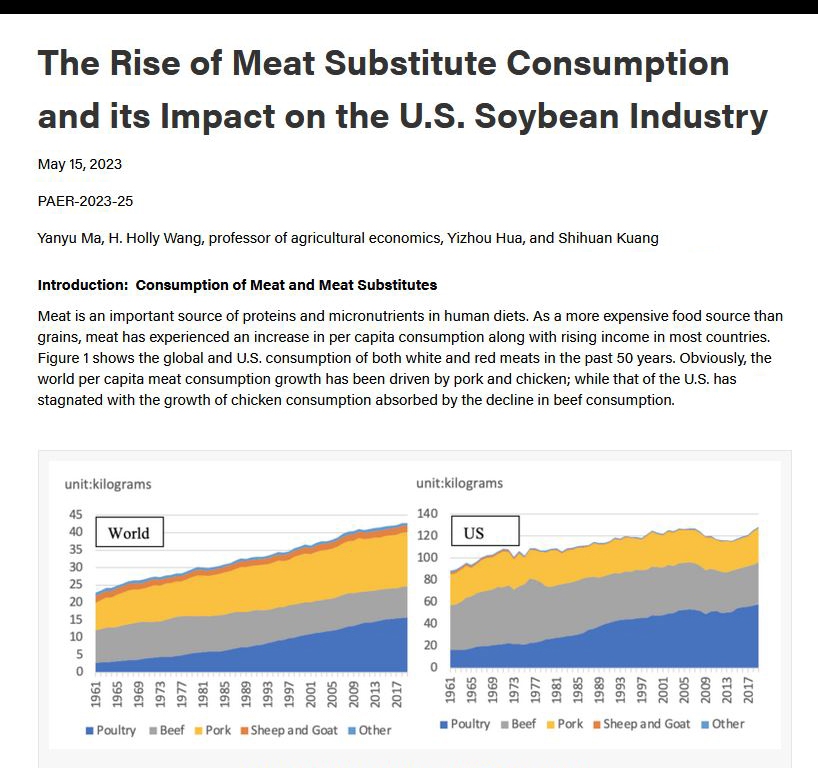As I’ve noted many times before, including in Soy 101, grass-fed/pasture based grass finished cattle doesn’t eat much if any soy, and grass-fed/feed lot grain-finished cattle eats very little soy (largely husks in the form of pellets). This recent paper, The Rise of Meat Substitute Consumption and its Impact on the U.S. Soybean Industry, from Purdue University reaffirms this second point about conventional US beef production.
As noted in this paper: “…The total amount of feed excluding harvested forages fed to beef cattle equals approximately 64.5 million tons in 2019 in the U.S. Roughly 57% of this amount came from corn and only roughly 4% was soy-related ingredients…”

The researcher’s analysis, based on certain assumptions, goes on to note that plant based and especially cell-Ag proteins increase the markets for soybean since soy isolates are used in many of the plant based products and soy hydrolysate is the most available source of amino acids used in the cell media to grow the stem cells. So they conclude, “…Our major results show that one unit of conventional beef, plant-based beef and cell-cultured beef would require 0.24, 0.54 and 1.44 units of soybeans, respectively, to feed…”
In other words, plant based “meat” and cell Ag actually increases the demand for soy since these forms of alt protein require respectively over two (2) to nearly six (6) times the amount of soy that’s required for conventional beef.
Thus that’s part of the folly focusing these technologies primarily on beef. Why? Beef cattle can be raised almost entirely on inedible to human grasses, forbs and crop by-products. Too often people citing feed-conversion ratios don’t differentiate between edible versus inedible to human forms of feeds and forages. Therefore their statistics are greatly distorted. Confined chickens and pigs consume most of the soybean meal. Humans use the soybean oils. But chicken and pork aren’t as profitable for alt proteins producers especially since both pork and chicken have already been verticalized and corporatized. Beef cattle production hasn’t been verticalized. Verticalization of grazing ruminants is much harder to do. Thus the focus on beef substitutes especially burgers. This difficulty to verticalize beef and other ruminant production has also resulted in a lot of reductive methane math to rationalize feedlots and other industrial forms of “intensification”.
(Note, as a quick commentary, chicken, and pigs should be fed more direct food waste and indirect food waste fed to black soldier flies. Black soldier fly feeds are also suitable for the aquaculture industry).
Getting back to the subject of the need for more soy for alt-proteins, is it really any wonder then that all of these large soybean producers and processors (Cargill, ADM, Bunge, etc) are some of the largest investors in the alt-protein sector? All of these corporations, as well as meat packers, are rebranding themselves as protein companies. They don’t view plant-based, recombinant (fermented), or cell-Ag sources of protein as being “disruptive”. No, they view these other sources of protein as additional revenue streams and part of their protein portfolio to fulfill growing global demand for protein. They don’t care whether their industrially grown mono-cropped soy is fed to livestock in confined operations, is ultra-processed into soy isolates made into ultra-processed plant based patties, or is used as soy hydrolysate to feed growing stem cells in bioreactors.
(As another side note, protein from precision fermentation could also be used in place of soy isolates and hydrolysates, but that requires even more capital intensive infrastructure plus a lot more energy. I wrote about the folly of such a strategy in this old blog: Techno-optimism run amok… George Monbiot’s latest delusion).
Given this huge investment by these large soya producers/processors, anyone who thinks that all the various forms of alt proteins won’t lead to further consolidation and corporatization of the food supply is seriously deluded. (That includes you, George). Additionally, since soya is largely the end game in the deforestation process, being a lot more profitable than beef cattle, anyone who believes alt proteins will reduce the rate of deforestation has also been stiffing way too much glue. In the Cerrado, land gets converted straight into soya. In the Amazon, the 2006 Amazon Soy Moratorium delays this conversion for two years. Beef cattle are the place holders until flat land is no longer considered “newly” cleared. Again, as I detailed in Soy 101, soybean meal and oil have many uses. Though, again for emphasis, ironically beef cattle feed isn’t one of those uses at any significant scale.
As I’ve also noted in prior blogs, including The Ecocide Burger, industrially grown mono-cropped soy is very deleterious. This form of production basically causes dead zones due to trophic collapse of ecosystems from the soil food web on up. So plenty of animals die for this commodity crop. Neonics used on seeds, herbicides and fertilizer inputs also have a very adverse impacts on the environment. For example, leached phosphate that gets into waterways causes algae blooms and hypoxia that kills pretty much everything in those waterways. So needless to say, increased industrial soy production for isolates and hydrolysates pretty much negates any claims about reducing animal deaths and being better for the environment. Such claims are just false marketing.
Now there are better ways to grow soybeans and other proteins just as there are better ways to raise livestock. Some of the best ways to grow crops and raise livestock are in integrated regenerative systems. One example is growing sacha inchi seeds in regenerative dynamic agroforestry systems on areas of tropical forest that have been destroyed and abandoned. These seeds have an amino acid profile similar to soy, a much better Omega 3 to 6 ratio, plus can be grown in acidic (oxalic) rain forest soils without the need for lime and phosphates. I’ll discuss this system and some other integrated regenerative systems in more detail in another forthcoming blog.
So, once again, what really matters is food production. That is the HOW and appropriateness of WHERE often more so than the WHAT. Any food item can be grown, raised or caught in a variety of ways that range from very bad to very good. Therefore, rather than label foods as “good” or “bad” plus incessantly argue over the false dichotomy of meats versus plants, the real focus should be on best practices of food production. So this means regenerative systems stacking enterprises to produce the same or more amount of food per acre than degenerative systems that destroy soil health, biodiversity, and the environment. This includes any and all sorts of animal and plant proteins. Thus, for land based systems, the real goal is to reduce tillage, pesticides, synthetic/mined fertilizers, mono-crops and bare fallows.
Or, in other final words, whether one wants to get their protein from beef, lamb, chicken, soybeans, peas, sacha inchi seeds, etc, those proteins should come from regenerative systems of food production rather than degenerative ones.
#

5 thoughts on “The irony of protein corporations”